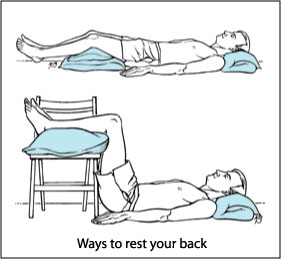Low Back Pain: Tips on Pain Relief and Prevention
What can cause low back injuries?
Many things can cause low back injuries-muscle strain or spasm, sprains of ligaments (which attach bone to bone), joint problems or a “slipped disk.” The most common cause is using your back muscles in activities you’re not used to, like lifting heavy furniture or doing yard work.
A slipped disk happens when the disk between the bones bulges and presses on nerves. This is often caused by twisting while lifting. But many people won’t know what caused their slipped disk.
What can I do for relief when I’ve hurt my lower back?

The best position for relief when your back hurts is to lie on your back on the floor with pillows under your knees, with your hips and knees bent and your feet on a chair, or just with your hips and knees bent. This takes the pressure and weight off your back.
If you’re resting a hurt back, you may need 1 to 2 days of this sort of rest. Resting longer than this can cause your muscles to weaken, which can slow your recovery. Even if it hurts, walk around for a few minutes every hour.
What else can I do for relief?
Heating pads can help to relax painful muscle spasms. Use heat for 20 to 30 minutes at a time. Ice packs and massages may also give relief.
Nonprescription medicines that reduce pain or swelling include aspirin, acetaminophen (brand name: Tylenol), naproxen (brand name: Aleve), ketoprofen (brand name: Orudis), and ibuprofen (brand name: Motrin).
Call your family doctor if:
- Pain goes down your leg below your knee.
- Your leg, foot, groin or rectal area feels numb.
- You have fever, nausea or vomiting, stomachache, weakness or sweating.
- You lose control over going to the bathroom.
- Your pain was caused by an injury.
- Your pain is so intense you can’t move around.
- Your pain doesn’t seem to be getting better after 2 to 3 weeks.
Is there relief for ongoing back problems?
Treatment of ongoing back problems must be directed at the cause. This may mean losing weight (because being overweight can make back pain worse), getting your muscles in better shape, and improving your posture when you’re sitting, standing and sleeping.
Tips for preventing back strain
- Don’t lift by bending over. Lift an object by bending your hips and knees and then squatting to pick up the object. Keep your back straight and hold the object close to your body. Avoid twisting your body while lifting.
- Push rather than pull when you must move heavy objects.
- If you must sit at your desk or at the wheel of a car or truck for long hours, break up the time with stops to stretch.
- Wear flat shoes or shoes with low heels (1 inch or lower).
- Exercise regularly. An inactive lifestyle contributes to lower back pain.
What’s the best way to sit?
Sit in chairs with straight backs or low-back support. Keep your knees a little higher than your hips. Adjust the seat or use a low stool to prop your feet on. Turn by moving your whole body rather than by twisting at your waist.
When driving, sit straight and move the seat forward. This helps you not lean forward to reach the controls. You may want to put a small pillow or rolled towel behind your lower back if you must drive or sit for a long time.
What’s the best position for standing?
Good postureIf you must stand for long periods, rest 1 foot on a low stool to relieve pressure on your lower back. Every 5 to 15 minutes, switch the foot you’re resting on the stool. Maintain good posture: Keep your ears, shoulders and hips in a straight line, with your head up and your stomach pulled in.
What’s the best position for sleeping?
The best way to sleep is on your side with your knees bent. You may put a pillow under your head to support your neck. You may also put a pillow between your knees.
If you sleep on your back, put pillows under your knees and a small pillow under your lower back. Don’t sleep on your stomach unless you put a pillow under your hips.
Use a firm mattress. If your mattress is too soft, use a board of 1/2-inch plywood under the mattress to add support.
What exercises can I do to strengthen my back?
Some specific exercises can help your back. One is to gently stretch your back muscles. Lie on your back with your knees bent and slowly raise your left knee to your chest. Press your lower back against the floor. Hold for 5 seconds. Relax and repeat the exercise with your right knee. Do 10 of these exercises for each leg, switching legs.
While some exercises are specific for your back, it’s also important to stay active in general. Swimming and walking are good overall exercises to improve your fitness.
Revision date: June 18, 2011
Last revised: by Dave R. Roger, M.D.